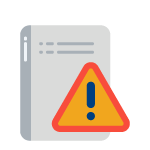Why do we need warning notices in technical documentation?
Technical writers are required to design their technical documentation in such a way that the use or maintenance of the products described in it is as safe as possible for users. So you could say that warning notices are there to make products safer for users. If manufacturers do not include any or adequate warnings, they are exposing themselves to considerable legal risks.
The inclusion of warning notices in technical documentation is not a random process, as they are often based on the risk assessment from the product development stage. Alternatively, warning notices may also be developed during the technical writing process if additional sources of danger are identified here that ensue from the operation or maintenance of a product.
What is the difference between warning notices and safety notices in technical documentation?
They differ in terms of their role and also their location in the instructions:
- Warning notices are positioned immediately before the actions where the risk is relevant. They should directly protect users from risks that may occur during a specific activity.
- Safety notices are general notices that are relevant to the entire use of the product. They are normally located at the start of the document. A typical safety notice may refer to the risk from electric voltage if the product is connected to a power source during use.
How should warning notices be designed and the text structured?

When it comes to the structure of the contents, the warning symbols to be used, and the presentation of warning and safety notices, there are various standards that help to ensure operating instructions are produced correctly. Ideally, the use of warning notices in technical writing should adhere to a specific standard. This will ensure that technical writers do not forget any key points when writing and it’s easier to spot at the approval stage if something is missing.
How do I use the SAFE formula?
The SAFE formula forms the basis for a widely used type of warning notice in technical writing. Each letter in this abbreviation represents a particular aspect of the warning notice. Let’s look at each letter in turn:
- S = signal word/severity of the hazard: The signal word (e.g., “Danger”, “Warning”, “Note”) not only indicates the presence of a hazard, it also denotes its severity. The signal word is often highlighted using color or a symbol.
- A = Analysis of the source and nature of the risk: This clearly describes the nature of the hazard and what causes it. Taking the example of a hairdryer, that might be “Danger from electric current”.
- F = Further consequences: What could/would happen if the hazard were to materialize? The further consequences will differ according to the nature of the hazard. In the worst case, that would (if you were to take your hairdryer into the shower) be the danger of death.
- E = Evasion: What do I have to do to ensure the hazard never occurs? Sometimes it’s easy (don’t let your hairdryer come into contact with water), but sometimes it’s really complicated. The relevant section would then be moved to a separate chapter, with the warning notice just containing a reference to that chapter.
Why are warning notices in technical documentation often very detailed?
In a specific situation, a simple “Danger!” will often suffice, as it immediately attracts everyone’s attention. It’s a bit more complicated in the case of instruction manuals. The hazard is frequently not obvious. Technical writing therefore also has to ensure that it warns against hazards that perhaps aren’t obvious to users at first glance.
In addition, technical writers normally don’t know exactly who’ll be reading and using the manual. When we meet people face-to-face, we can often quickly weigh up whether a single word is all that is needed as a warning, or whether a longer explanation would be more appropriate.
What’s more, in the case of an instruction manual, we’ve no way of telling whether the reader has actually grasped the significance of the warning. Or – in the worst case – we find out when it’s already too late and the damage has been done. This is why warnings in instruction manuals must cover all the most significant points: What is the hazard? What could happen? How dangerous is it? And what can we do about it?
Where does the content for warning notices and safety notices come from?
Technical writers use results and documents that have already been created during the development process to produce warning and safety notices. The “risk assessment”, sometimes also referred to as a “hazard analysis”, plays an important role here.
A risk assessment is a document that is created during a machine’s development. It is prescribed by the EN ISO 12100 standard (Safety of machinery) and serves to document an iterative process, in which the manufacturer sets out to minimize the risk arising from using the machine prior to it being released onto the market. The resulting document is sometimes created by technical writers, but frequently also by others involved in the development process, such as development engineers and product managers.
Why can’t I just include the risk assessment in the instructions?
This would, of course, cover operational safety requirements with the minimum of effort. However, there are several reasons against including the whole risk assessment in the instructions:
- The general principle is that risks must be eliminated by modifying the machine. Only if this is not possible can the remaining risks be pointed out using warning notices in the instructions. So warnings are only included about risks that cannot be avoided.
- A risk assessment must state not only the risk, but also the basis on which this assessment was made. However, this information would be superfluous for the instructions. It would only create unnecessary additional reading.
- As the risk assessment is focused on the risks resulting from the machine, it may be organized around the individual components. However, the risks must be described from the users’ perspective. Switching perspective in this way is not always easy and users should never be put in this position. It would not immediately be obvious to everyone that, say, there is a risk of burns when shutting down the machine, even if in principle the users know that a certain component can become very hot during operation. Therefore, to be on the safe side, technical writers need to apply this change in perspective to the application situation.
This means: The risk assessment will identify the risk and leave it to the instructions to explain exactly how to avoid the risk. In this way, the risk assessment or hazard analysis takes on a sort of control function and identifies the sources of danger. The technical writing department will then research the precise steps to eliminate the risk for the instructions.
So, it is important to remember that risk assessments and warning notices in instructions are closely related. They should be looked at alongside one another to ensure the overall process runs smoothly. This will avoid duplication of effort and unnecessary queries from the outset.
When is a warning needed?
The answer to this is complex, as there are a number of competing factors around whether and when to insert a warning notice. Firstly, a warning should only be included if the hazard is unavoidable. If a hazard can be eliminated by constructing the device in a different way, then the device must be modified.
If the device is already finished, many technical writers tend to include as many warnings as possible to ensure that every conceivable hazard has been addressed. You should avoid this typical mistake in the warning notices. Finally, it may be counterproductive if, for example, customers feel that what is in fact a harmless product is portrayed as being hugely complex and dangerous. On the other hand, a warning must be present if there is a real danger. In some cases, a standard will even stipulate that a warning notice is to be included. Technical writers should therefore use warnings judiciously.
Where are warnings placed in operating instructions?
There are two well-defined locations where warnings are placed in instruction manuals.
- In the safety chapter at the beginning of the manual
The safety chapter contains a summary of the product’s hazard potential and explains how users can nevertheless operate it safely despite the residual risks. The correct technical description of the warnings it contains is Safety notices. They are frequently formulated in more detail and are less rigorously standardized than warning notices that follow the SAFE formula.
2. Before an action
The other appropriate location for warnings is anywhere in the manual where users are instructed to carry out a particular operation, typically in step-by-step instructions. It is important that the warning is issued before the user carries out what might be a potentially dangerous action. This is the domain of the warning notice, which alerts the user to proceed with the utmost caution at this point.
The fact that the same hazard may exist in several different scenarios also means that the same warning notice can crop up several times within a manual. This particular challenge is easily overcome using modularization and a component content management system, such as SCHEMA ST4.


